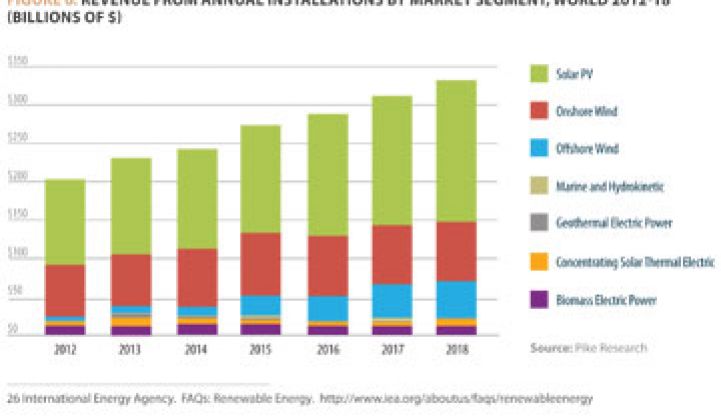At first it looks like a rosy picture. From 2012 to 2018, the world’s clean energy sector could generate nearly $2 trillion in revenue.
But much of that is not in the U.S., for a variety of reasons, and the U.S. is barely keeping up, according to a new report from The Pew Charitable Trusts, Innovate, Manufacture, Compete: A Clean Energy Action Plan.

“Once a world leader in innovation and manufacturing of clean energy technologies, the United States now faces considerable competitive challenges,” the report authors write. “It lags other nations on a variety of measures, including clean energy deployment and manufacturing. Even its long-standing lead in innovation is at risk.”
The report finds that cumulative clean energy installations in the U.S. could reach 126 gigawatts. While the bulk of that will be wind and solar PV, there are small but growing installations of offshore wind and biomass. When the nonprofit interviewed industry leaders, the lack of political certainty topped the list of impediments to the industry. There are bright spots, such as third-party financing models for solar PV and the glimmer of offshore wind in the U.S. Energy efficiency was not part of the study.
But for every gain, there is far more that needs to be done, according to the report. Pew made six policy recommendations:
- Establish a clean energy standard to guide deployment and investment for the long term. The report describes renewable policy as “episodic.” The industry is not looking for open-ended incentives, but rather clear ones that aren’t renewed on a short-term basis.

- Enact a multiyear but time-limited extension of tax credits for clean energy sources. As described above, the industry needs clarity in policy, especially with the production tax credit for wind.
- Significantly increase investment in energy research and development. The U.S. ranks eighth among the G-20 nations in investment intensity, according to their report, and tenth in the world in installed clean energy capacity growth rate since 2006. In recent years, the U.S. is only trailing further.
-
Level the playing field across the energy sector by evaluating barriers to competition. It’s no secret that energy of all stripes receives subsidies and tax breaks. There is no expectation that fossil fuel subsidies would ever be eliminated completely, but Pew noted that there are many ways to level the playing field, such as taking into account water usage in energy production. Regulation, such as changing who can sell electricity, is another approach that could open the market to new players.
- Renew incentives for domestic clean energy manufacturing. Pew calls for an increase in the advanced energy manufacturing tax credit, Section 48C program, to create jobs and help support the U.S. clean energy economy.
- Create a strategy to expand markets for clean energy goods and services abroad. The report notes that there is expected to be $6 trillion worth of clean energy investment in the next quarter century, and much of that will be in emerging economies. But the U.S. could be an exporter of technologies, including microgrid and renewable solutions for developing nations that lack full electric grids.
“Our research shows that there is a multi-trillion-dollar opportunity in the clean energy sector,” said Phyllis Cuttino, director of Pew’s Clean Energy Program. “U.S. industry has the capacity to be a leader, provided we have the right policies in place. It’s time for Congress to support a comprehensive energy strategy by delivering long-term certainty for businesses and investors in renewable power.”
Let’s see what the 113th Congress can accomplish.



